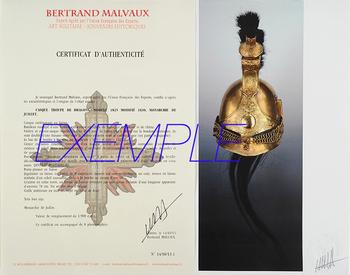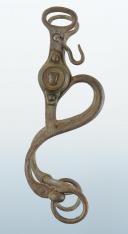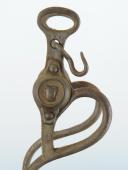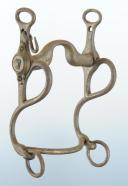
CUIRASSIERS BRIDLE BIT, model 1861, Second Empire. 5885-A20
Sold out
CUIRASSIERS BRIDLE BIT, model 1861, Second Empire. 5885-A20
S-shaped temples of the so-called "Condé" model with brass bosses representing a breastplate molded in relief.
France.
Second Empire.
Very good condition, to be cleaned.
ORIGIN :
Former Hippolyte Marie-Joseph Boivin collection (Guermantes, September 8, 1857, Bouvresse June 19, 1912).
This scholar from the end of the 19th century constitutes a collection of patriotic earthenware of great importance, having been exhibited several times in French museums.
With a collector's temperament, Hippolyte Boivin brings together earthenware from Rouen, Marseille, Strasbourg, Delft, Nevers, watches with enameled dials from the First Empire, old members, cabinets and clocks from Normandy and Picardy, chests and clocks from various periods, tapestries, rattles from all over France and even abroad.
His grandson says that H. Boivin and his wife moved from village to village, buying all the objects that seemed of some interest to them. These acquisitions enriched his own collections and those of the Beauvais museum, of which he was curator from 1889 to 1912. In this collecting business, he was also passionate about military souvenirs, mainly headdresses, copperwork, bridle bits and various souvenirs. historical.
He had a gallery built in his garden to house his military collections which would later be presented in the “Boivin room” of the Dejean barracks (Amiens), destroyed during the Second World War. Hippolyte Boivin demonstrates his predilection for patriotic earthenware by reproducing the pieces he collected through drawing and watercolor. Two reasons can explain this attraction: firstly the exile of his family of Champagne origin during the German invasion of 1870 may have given him a taste for patriotic and military objects; then, the profession of his maternal grandfather, operating a stoneware pottery factory in La Chapelle-aux-Pots, may have encouraged his attraction to ceramics.
The objects constituting the collection of this enlightened amateur were therefore all purchased according to the opportunities encountered in the “field”, which is moreover given the period of collection: from the fall of Napoleon III and until the eve of the Great War, their homogeneity was particularly preserved.
S-shaped temples of the so-called "Condé" model with brass bosses representing a breastplate molded in relief.
France.
Second Empire.
Very good condition, to be cleaned.
ORIGIN :
Former Hippolyte Marie-Joseph Boivin collection (Guermantes, September 8, 1857, Bouvresse June 19, 1912).
This scholar from the end of the 19th century constitutes a collection of patriotic earthenware of great importance, having been exhibited several times in French museums.
With a collector's temperament, Hippolyte Boivin brings together earthenware from Rouen, Marseille, Strasbourg, Delft, Nevers, watches with enameled dials from the First Empire, old members, cabinets and clocks from Normandy and Picardy, chests and clocks from various periods, tapestries, rattles from all over France and even abroad.
His grandson says that H. Boivin and his wife moved from village to village, buying all the objects that seemed of some interest to them. These acquisitions enriched his own collections and those of the Beauvais museum, of which he was curator from 1889 to 1912. In this collecting business, he was also passionate about military souvenirs, mainly headdresses, copperwork, bridle bits and various souvenirs. historical.
He had a gallery built in his garden to house his military collections which would later be presented in the “Boivin room” of the Dejean barracks (Amiens), destroyed during the Second World War. Hippolyte Boivin demonstrates his predilection for patriotic earthenware by reproducing the pieces he collected through drawing and watercolor. Two reasons can explain this attraction: firstly the exile of his family of Champagne origin during the German invasion of 1870 may have given him a taste for patriotic and military objects; then, the profession of his maternal grandfather, operating a stoneware pottery factory in La Chapelle-aux-Pots, may have encouraged his attraction to ceramics.
The objects constituting the collection of this enlightened amateur were therefore all purchased according to the opportunities encountered in the “field”, which is moreover given the period of collection: from the fall of Napoleon III and until the eve of the Great War, their homogeneity was particularly preserved.
Reference :
5885-A20

Next update Friday, may 2 at 13:30 PM
FOR ALL PURCHASES, PAYMENT IN MULTIPLE CHECKS POSSIBLE
bertrand.malvaux@wanadoo.fr 06 07 75 74 63
An authenticity certificate of the item including the description published on the site, the period, the sale price, accompanied by one or more color photographs is automatically provided for any item priced over 130 euros. Below this price, each certificate is charged 5 euros.
Only items sold by me are subject to an authenticity certificate, I do not provide any expert reports for items sold by third parties (colleagues or collectors).


